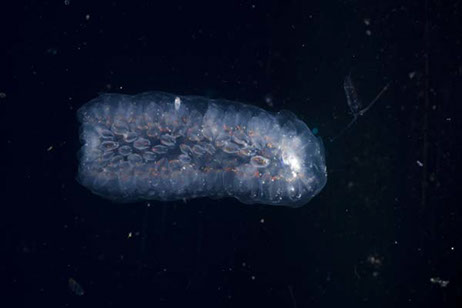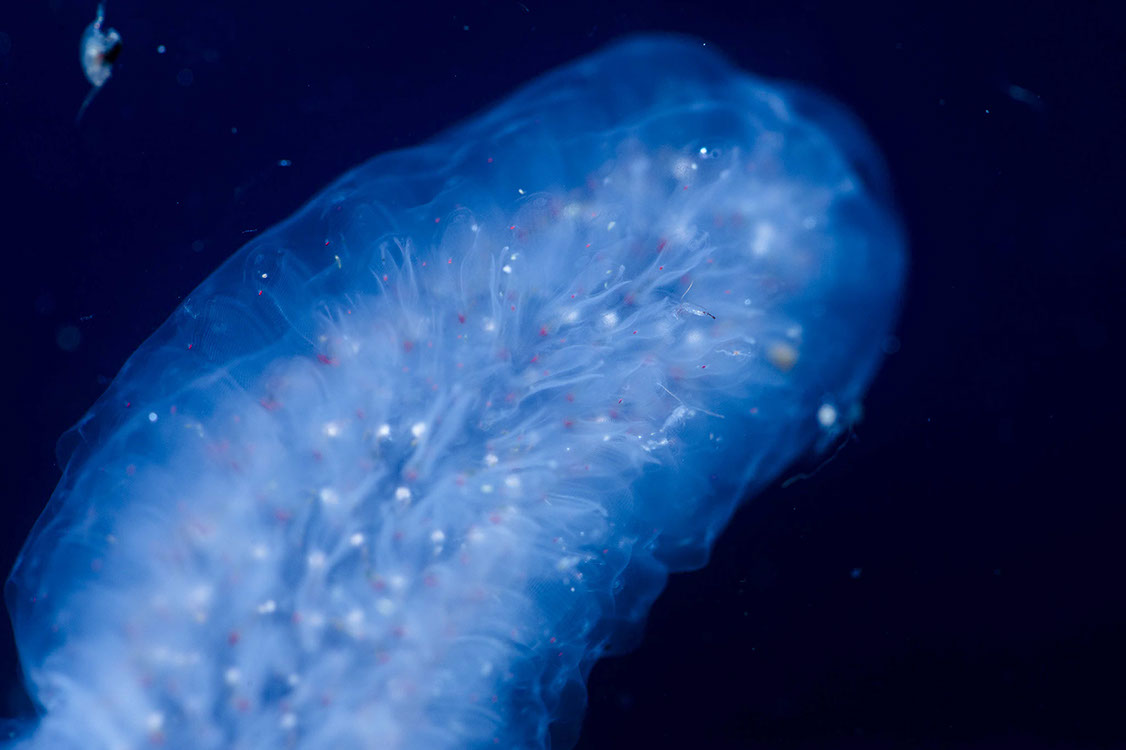Pyrosomes
Pyrosomes are a colonial form of pelagic tunicate. This means that (like salps, doliolids, and appendicularians) they are chordates but not vertebrates. They are more closely related to fish (and to us) than they are to other gelatinous zooplankton, like ctenophores, siphonophores, and true jellies. However, you would never guess this from looking at them. Pyrosomes are composed of individual zooids. Each zooid is similar to a salp or a doliolid in that it is a gelatinous organism that pushes water through itself and catches prey on an internal filter. However, in pyrosomes, the zooids are arranged together into a bag-like structure. Each zooid individually pump water from the outside of the bag to the inside of the bag. The water then leaves the colonial organism from the open end of the bag. In this way each organism is able to capture its prey, and by acting in concert they can move through the water to find more prey.
Pyrosomes vary widely in size. Although the individiual zooids are typically millimeter-sized, the colonial organism can range in size from a few inches (like the organism pictured to the right) to several meters in length. Some SCUBA divers have actually encountered pyrosomes large enough that they can actually swim inside of them. The ecological role of pyrosomes is poorly understood for a couple of reasons. First, they are quite patchy in the ocean (especially the large ones) - most of the time they will not be present, but sometimes they are very abundant. Second, they are fragile organisms and the large ones specifically are very difficult to capture without harming them. By comparison with their better studied relatives (salps and doliolids), we believe that pyrosomes are efficient filter feeders on relatively small protists, and possibly even bacteria. However, very few species of pyrosomes have been studied and we know little about their feeding selectivity. Understanding these creatures is important, however, because anecdotal evidence suggests that they may be increasing in abundance in the world ocean.
In a study led by our colleague Dr. Moira Decima, we quantified the abundances of a species of large pyrosome (Pyrostremma spinosum) during a cruise in the Costa Rica Dome. Although P. spinosum was only captured in a fraction of our net tows, it dominated the total biovolume of the zooplankton community, because each colony was massive (by plankton standards). We measured colony volumes of up to 5.5 liters, although the actual colonies may have been substantially larger because we cannot rule out the possibility that these fragile organisms were broken apart by our nets. For comparison, the entire rest of the plankton community captured in one of our net tows is typically less than 0.1 liters. To investigate their ecological and biogeochemical impact, we used stable isotope analyses (carbon and nitrogen) and gut pigment analyses of the chlorophyll (indicative of feeding on algae) and phycoerythrin (indicative of feeding on the cyanobacterium Synechococcus) inside the zooids. We found that P. spinosum had a substantial impact on the total phytoplankton community, but that it was likely not feeding efficiently on cyanobacteria. We also discovered that (unlike the rest of the zooplankton community) it was primarily feeding beneath the mixed layer, where it may play an important role in consuming slowly-sinking particles. To see the manuscript based on our study, click here.

This portion of our website is specifically designed as outreach to the general public. If you are a scientist look for details about our research, please click on the red 'For Scientists' link on the top right.
Contact: Mike Stukel (mstukel@fsu.edu)
Florida State University
Dept. of Earth, Ocean, and Atmospheric Science
Center for Ocean-Atmospheric Prediction Studies
